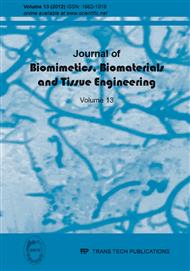[1]
K.A. Hing, Bone repair in the twenty-first century: biology, chemistry or engineering?, Phil. Trans. R. Soc. Lond. A. 362 (2004) 2821–2850.
Google Scholar
[2]
S.E. Feinberg, T.L. Aghaloo, L.L. Cunningham, Role of tissue engineering in oral and maxillofacial reconstruction, Findings of the 2005 AAOMS Research Summit, J. Oral Maxillofac. Surg. 63 (2005)1418-1425.
DOI: 10.1016/j.joms.2005.07.004
Google Scholar
[3]
P. Ducheyne, Q. Qiu, Bioactive ceramics: the effect of surface reactivity on bone formation and bone cell function, Biomaterials. 20 (1999) 2287-2303.
DOI: 10.1016/s0142-9612(99)00181-7
Google Scholar
[4]
G. Heness, B. Ben-Nissan, Innovative bioceramics, Materials Forum. 27 (2004) 104-114.
Google Scholar
[5]
L.F. Liang, X.Y. Han, X.C. Yan, W. Jie, Reinforcing of Porous Hydroxyapatite Ceramics with Hydroxyapatite Fibres for Enhanced Bone Tissue Engineering, J. Biomim. Biomater. Tissue Eng. 10 (2011) 67-73.
DOI: 10.4028/www.scientific.net/jbbte.10.67
Google Scholar
[6]
E. Soh, A.J. Ruys, Characterisation of foamed porous alumina tissue scaffolds, J. Biomim. Biomater. Tissue Eng. 4 (2009) 21-26.
DOI: 10.4028/www.scientific.net/jbbte.4.21
Google Scholar
[7]
W. Cao, L.L. Hench, Bioactive materials, Ceram. Int. 22 (1996) 493-507.
Google Scholar
[8]
M. Takemoto, S. Fujibayashi, M. Neo, J. Suzuki, T. Kokubo, T. Nakamura, Mechanical properties and osteoconductivity of porous bioactive titanium, Biomaterials. 26 (2005) 6014–6023.
DOI: 10.1016/j.biomaterials.2005.03.019
Google Scholar
[9]
B.L. Seal, N.C. Otero, A. Pantich, Polymeric biomaterials for tissue and organ regeneration, Mat. Sci. Eng. R. 34 (2001) 147-230.
Google Scholar
[10]
A. Abarrategi, M.C. Gutiérrez, C. Moreno-Vicentea, M.J. Hortigüela, V. Ramosa, et al. Multiwall carbon nanotube scaffolds for tissue engineering purposes, Biomaterials. 29 (2008) 94–102.
DOI: 10.1016/j.biomaterials.2007.09.021
Google Scholar
[11]
R. Chalasani, L. Poole-Warren, M. Conway, B. Ben-Nissan. Porous Orbital Implants in Enucleation: A Systematic Review, Surv. Ophthalmol. 52 (2007) 145-155.
DOI: 10.1016/j.survophthal.2006.12.007
Google Scholar
[12]
D. Sami, S. Young, R. Petersen, Perspective on Orbital Enucleation Implants, Surv. Ophthalmol. 52 (2007) 244-265.
DOI: 10.1016/j.survophthal.2007.02.007
Google Scholar
[13]
A. Perry, Porous orbital implant structure, US Patent 6, 063, 117 (2000).
Google Scholar
[14]
D.M. Roy, S.K. Linnehan, Hydroxyapatite formed from Coral Skeletal Carbonate by Hydrothermal Exchange, Nature. 247 (1974) 220-222.
DOI: 10.1038/247220a0
Google Scholar
[15]
A. Perry, Device for orbital implant, US Patent 4, 976, 731 (1990).
Google Scholar
[16]
M. Governa, G. Marchini, C. Brunelli, A. Dall'Antonia, D. Barisoni, Hydroxyapatite orbital implant covered with fascia lata in post-enucleation eye reconstruction, Eur. J. Plast Surg. 26 (2003) 331-334.
DOI: 10.1007/s00238-003-0559-9
Google Scholar
[17]
J.P. Adenis, M.P. Boncoeur-Martel, P.Y. Robert, Hydroxyapatite orbital implant exposure: symptoms, physiopathology, treatment, in: R. Guthoff, J.A. Katowitz (Eds. ), Oculoplastics and Orbit, Springer, 2007, 171-180.
DOI: 10.1007/978-3-540-33677-8_11
Google Scholar
[18]
P. Custer, R.H. Kennedy, J.J. Woog, J.J. Kaltreider, Orbital implants in enucleation surgery. A report by the American Academy of Ophthalmology, Ophthalmology. 110 (2003) 2054-(2061).
DOI: 10.1016/s0161-6420(03)00857-1
Google Scholar
[19]
M. Vittorino, F. Serrano, F. Suárez, Enucleation and evisceration: 370 cases review. Results and complications, Arch. Soc. Esp. Oftalmol. 82 (2007) 495-500.
Google Scholar
[20]
J.S. Song, O.Y. Oh, S.H. Baek, A survey of satisfaction in anophthalmic patients wearing ocular prosthesis, Graef. Arch. Clin. Exp. Ophthalmol. 244 (2006) 330–335.
DOI: 10.1007/s00417-005-0037-0
Google Scholar
[21]
B. Kundu, M.K. Sinha, S. Mitra, D. Basu, Synthetic hydroxiapatite-based integrated orbital implants: a human pilot trial, Indian J. Ophthalmol. 53 (2005) 235-241.
DOI: 10.4103/0301-4738.18904
Google Scholar
[22]
P. Viswanathan, M.S. Sagoo, J.M. Olver. UK national survey of enucleation, evisceration and orbital implant trends, Brit. J. Ophthalmol. 91 (2007) 616-619.
DOI: 10.1136/bjo.2006.103937
Google Scholar
[23]
K. Pal, S. Bag, S. Pal, Development of porous ultra-high molecular weight polyethylene scaffolds for the fabrication of orbital implant, J. Porous Mater. 15 (2008) 53–59.
DOI: 10.1007/s10934-006-9051-9
Google Scholar
[24]
L. Montanaro, Y. Jorand, G. Fantozzi, A. Negro, Ceramic Foams by Powder Processing, J. Eur. Ceram. Soc. 8 (1998) 1339-1350.
DOI: 10.1016/s0955-2219(98)00063-6
Google Scholar
[25]
H.R. Ramay, M. Zhang, Preparation of porous hydroxyapatite scaffolds by combination of the gel-casting and polymer sponge methods, Biomaterials. 24 (2003) 3293–3302.
DOI: 10.1016/s0142-9612(03)00171-6
Google Scholar
[26]
Y.K. Jun, W.H. Kim, O.K. Kweon, S.H. Hong, The fabrication and biochemical evaluation of alumina reinforced calcium phosphate porous implants, Biomaterials. 24 (2003) 3731–3739.
DOI: 10.1016/s0142-9612(03)00248-5
Google Scholar
[27]
A.R. Fariza, A. Zuraida, I. Sopyan. Application of low cost polyurethane foam for fabricating porous tri-calcium phosphate, J. Biomim. Biomater. Tissue Eng. 8 (2010) 1-7.
DOI: 10.4028/www.scientific.net/jbbte.8.1
Google Scholar
[28]
J. Liu, Z. Dong, X. Miao, Porous alumina-zirconia composite scaffold with bioactive glass 58S33C coating, J. Biomim. Biomater. Tissue Eng. 6 (2010) 87-104.
DOI: 10.4028/www.scientific.net/jbbte.6.87
Google Scholar
[29]
A.H. De Aza, J. Chevalier, G. Fantozzi, M. Schehl, R. Torrecillas, Crack growth resistance of alumina, zirconia and zirconia toughened alumina ceramics for joint prostheses, Biomaterials. 23 (2002) 937–945.
DOI: 10.1016/s0142-9612(01)00206-x
Google Scholar
[30]
J. Brandt, S. Henning, G. Michler, W. Hein, A. Bernstein, M. Schulz, Nanocrystalline hydroxyapatite for bone repair: an animal study, J. Mater. Sci. –Mater. Med. 21 (2010) 283-294.
DOI: 10.1007/s10856-009-3859-1
Google Scholar
[31]
A. Cuneyt Tas, F. Korkusuz, M. Timucin, N. Akkas, An investigation of the chemical synthesis and high-temperature sintering behaviour of calcium hydroxyapatite and tricalcium phosphate bioceramics, J. Mater. Sci. -Mater. Med. 8 (1997) 91 - 96.
DOI: 10.1023/a:1018506800033
Google Scholar
[32]
O.L. Smorygo, L.V. Tsedik, L.K. Yakhnitskaya, Y.D. Kovalenko, V.L. Krasilnikova, A.I. Kulak, L.A. Lesnikovich, Orbital implant, Belarus Patent 1, 385 (2004).
Google Scholar
[33]
O. Smorygo, V. Mikutski, A. Marukovich, A. Ilyushchanka, V. Sadykov, A. Smirnova, An inverted spherical model of an open-cell foam structure, Acta Materialia. 59 (2011) 2669–2678.
DOI: 10.1016/j.actamat.2011.01.005
Google Scholar
[34]
M.F. Ashby, The properties of foams and lattices, Phil. Trans. R. Soc. A. 364 (2006) 15–30.
Google Scholar
[35]
R. Brezny, D.J. Green, Fracture behaviour of open-cell ceramics. J. Am. Ceram. Soc. 72 (1989) 1145-1152.
Google Scholar
[36]
R. Brezny, D.J. Green, C.Q. Dam, Evaluation of strut strength in open-cell ceramics, J. Am. Ceram. Soc. 72 (1989) 885-889.
DOI: 10.1111/j.1151-2916.1989.tb06239.x
Google Scholar


